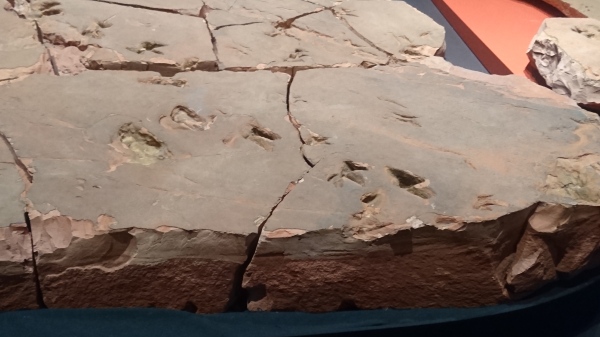 |
| Fossil dinosaur footprint, Wyoming, Fall 2005. |
def. Ichnite:
A fossilized footprint.
An ichnite is a type of trace fossil, which is a fossil that preserves evidence of biological activity but which is not part of an organism’s body. Examples of trace fossils are footprints (ichnites), burrows, and root cavities. Coprolites and other fossilized bodily excretions are also often considered trace fossils.
Footprints are everywhere. Just today, I went for a walk along a Cape Cod beach and there were footprints all over the beach. Footprints are rarely preserved as fossils, but when they are preserved the resulting ichnites can be spectacular. What kid- or grown-up- doesn’t find dinosaur footprints fascinating? Dinosaur (and other) ichnites are also very important for learning about how ancient animals moved.
 |
| Footprints on a Cape Cod beach, December 2010. |
 |
| More footprints on a Cape Cod beach, December 2010. |
During my undergraduate field camp, we did an exercise where we had to figure out how quickly various dinosaurs moved based on fossilized footprint trails. Using the size of the footprint and the distance between the footprints, you can estimate approximate dinosaur speeds. In field camp we did this for various tracks in Wyoming and Utah. Then, we ran as fast as we could and calculated our own speeds to see if any of us could outrun certain carnivorous dinosaurs. In most cases, we were slower than dinosaurs and would be a likely lunch for any dinosaurs brought back to life Jurassic Park style. Below are a few pictures I took during my undergraduate field camp of some dinosaur ichnites.The footprint fossils are a little difficult to make out from a distance, so we marked them with brightly-colored poker chips.
 |
| Fossilized dinosaur footprints, Wyoming, Fall 2005. |
 |
| Fossilized dinosaur footprints, Wyoming, Fall 2005. |
I have to say, though, that my favorite type of ichnite is the preserved footprints of ancient man, such as the famous Laetoli footprints in Tanzania. The Laetoli footprints (see pictures below) are 3.6 million years old and were made when Austrolopithecus afarensis walked through volcanic ash. Notice that there are actually two sets of footprints- one smaller, one larger- of two Austrolopithecus afarensis walking side-by-side, perhaps a mother and child or a man and a woman. These footprints show that very early man walked in a very similar way to modern man… even 3.6 million years ago!
 |
| Laetoli footprints, Tanzania. Image taken from here. |
 |
| Laetoli footprint, Tanzania. Image taken from here. |











